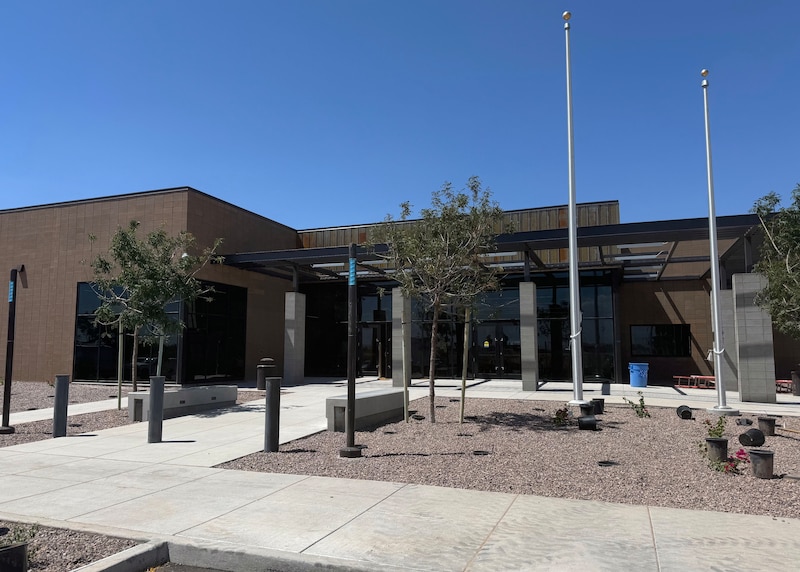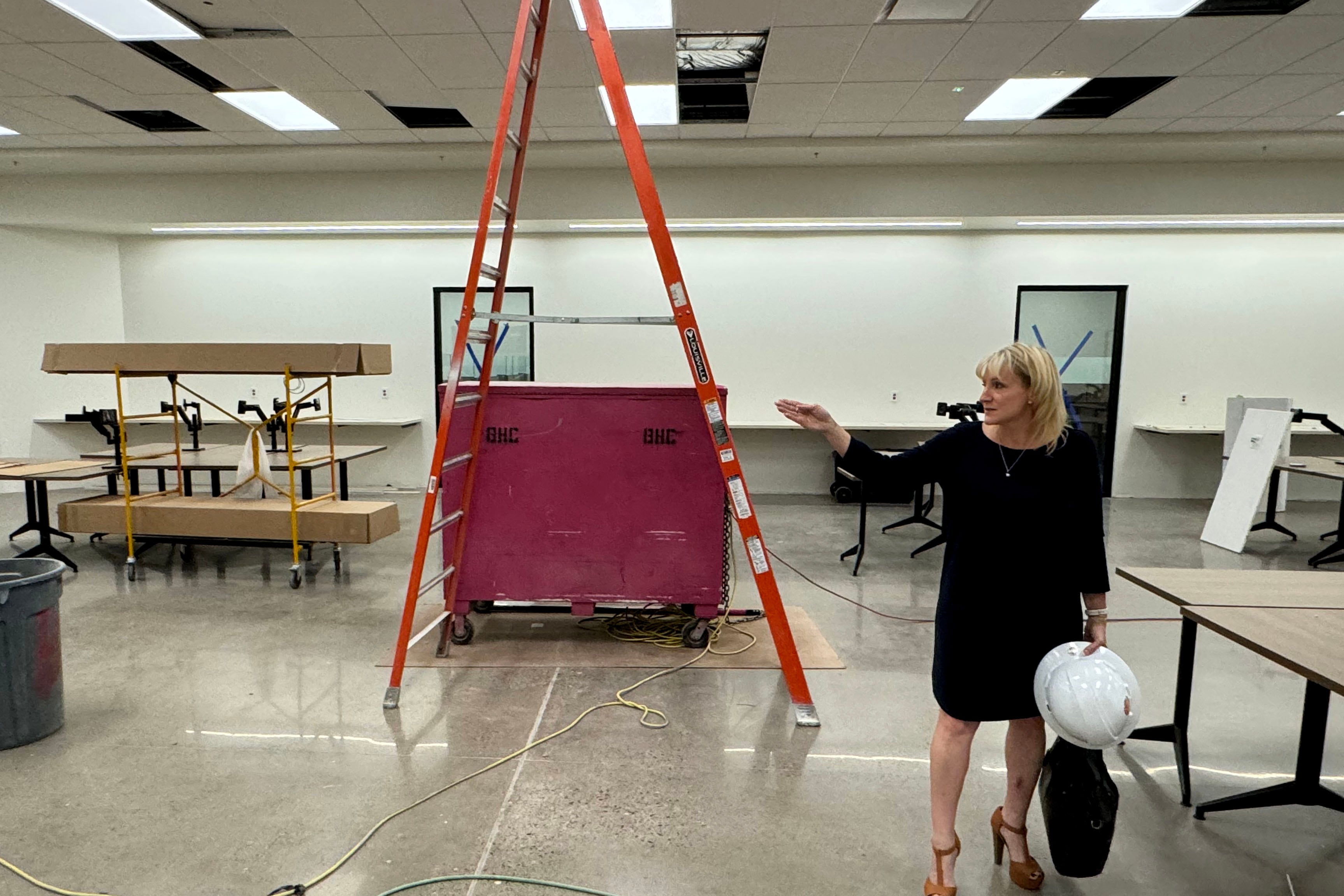Votebeat is a nonprofit news organization reporting on voting access and election administration across the U.S. Sign up for Votebeat Arizona’s free newsletter here.
When Pinal County Recorder Dana Lewis walked into the new elections building in mid-May, tiles were still missing from the ceilings.
The building was full of the sound of drilling, and of workers chatting while painting walls. The reception area walls needed fixing, equipment needed ordering — the list went on. There was a lot of construction work to do before this week’s planned ribbon-cutting — and in the quickly passing weeks left before 100,000 ballots cast by county voters in the high-stakes primary election would be delivered here.
To add to the complexity, Lewis’ staff, too, was undergoing a revamp of its own, shoring up procedures to prevent the mistakes that have led to embarrassing headlines under previous leaders.
“You want me to tell you I’m not nervous?” Lewis said while standing in the empty ballot vault, her voice echoing. She doesn’t quite say that.
“Um. I know my team. I know that they have made amazing things happen. And when things fell apart, they were able to keep their heads about them.”
Much has changed in Pinal County — the fast-growing exurbs southeast of Phoenix — since, as Lewis put it, “things fell apart” two years ago. During the 2022 primary election, some mail voters received ballots with mistakes. One-fourth of polling places experienced ballot shortages. Then, during the general election, the county initially failed to tally hundreds of properly cast ballots.
Lewis, who took control of the elections department last year, has led the construction of the new building, the hiring of new people, and an overhaul of many processes that’s meant to prevent errors in the coming elections. But she hasn’t been able to find an elections director, and some of the new processes remain new or imperfect.
The July 30 primary will be the county’s big test.
The presidential preference election in March went smoothly, for the most part. But records obtained by Votebeat through a public records request reveal a nagging problem behind the scenes: Poll workers are still struggling to document exactly how many ballots are being used by voters. That makes it hard for officials to later tell exactly how many ballots they should be tabulating, and confirm they aren’t missing any.
This will become even more difficult in November, when the county’s ballot may stretch two or even three pages long.
Lewis, a Republican running for a new term this year, has made more changes since March to try to make it easier on poll workers. But she said, while her office aims to have perfect numbers, she knows humans make mistakes.
“The public does expect us to be perfect,” she said. “And that is incredible.”
Pressure on recorder to perform
As Lewis was dodging ladders, construction materials, and extension cords last month, her team was in the midst of putting in place new processes meant to avoid the mistakes of the past.
They had just finished proofing 1,500 different versions of the primary ballot. The contests on each are slightly different, depending on where the voter lives and their political party. Lewis said she recruited county employees from other departments to help proof, ensuring that multiple people were looking at each version.
Her staff also must decide just how many ballots to order for each polling place. This is hard, because it’s never clear how many voters will choose to vote in person rather than casting a ballot by mail, and in the primary it’s unclear which political party ballot unaffiliated voters will select to cast.
While former elections director David Frisk was fired after he did not order enough ballots for August 2022, his replacement, now-retired elections director Virginia Ross, ordered far too many for November 2022. That’s not good, either: the sheer quantity of leftover ballots added to the difficulty poll workers had determining the correct number of ballots cast by voters
Lewis hopes their order this year will be closer to right. At the same time, she is trying to educate county officials, political party leaders, and the public about the potential advantages of switching to a voting model that allows poll workers to print voters’ ballots on demand. That would eliminate this problem.
Under the current system, she’s been telling people, there are “a whole lot of ballots that are going to get recycled because they weren’t voted.”
Poll workers made considerably fewer mistakes in March than in 2022 when noting the number of unused ballots at their locations. When reconciling ballots cast, the county tracked in a spreadsheet when the poll workers’ numbers were less than two or more than two ballots off. Only seven locations out of 52 made errors that were more than two ballots off, according to the document.
But in Arizona, margins can be razor-thin. The corrections the county made last election to its initial incorrect results, for example, were almost enough to overturn the statewide attorney general race.
One county supervisor, Kevin Cavanaugh, is concerned the county can’t figure out how to fully balance its numbers. He obtained the poll worker reports by reviewing documents Votebeat had requested and received from the county.
Before Lewis arrived at the elections center that day in mid-May, Cavanaugh, a Republican, unexpectedly questioned her about the documents at a public meeting.
“So, there is only an error of a couple of ballots — but on 20 different ballot reports,” Cavanaugh said to Lewis as she stood at the podium in front of the supervisors. “So that may be small, but I lost an election by 14 votes once. And that would be enough to change the results of an election. Do you plan on changing the way the form is designed? Training?”
Lewis explained a new vendor will be providing the pre-printed ballots packaged and tabbed in a way that will make it easier for poll workers to track.
Later in the day, at the elections center, she seemed exasperated that she had been put on the spot, saying she didn’t have a chance to effectively explain her answer.
“If a mistake is made, you think we don’t beat ourselves up every way until Tuesday?” she said. “Oh, yes we do. We lose sleep. We care about it. We are always looking at ways to improve the efficiency and efficacy of the process.”
In a phone interview after the meeting, Cavanaugh said he believes Lewis should have been more forthcoming about the errors.
“A county supervisor shouldn’t have to follow the lead of a news reporter to get information about the procedures of an election,” he said.
Cavanaugh, who is running for county sheriff, said he doesn’t have confidence that the election “will be run well and the results will be reliable or accurate in a timely way.”
But Supervisors Chairman Mike Goodman, also a Republican, said he has faith that Lewis has addressed the major issues with the county’s elections. He worries that the county hasn’t been able to recruit a new elections director, he said, but he believes Lewis has good people working for her.
“It doesn’t mean they aren’t going to make mistakes,” he said. “They are human and any time there are humans in the equation we are imperfect.”
New elections building gives breathing room
Officials moved into the new $32 million elections building in the county seat of Florence in early June. They’re calling it the VOTES building, which stands for Voter Operations Technology and Election Services.
The 53,000-square-foot building will give the county more than enough space, allowing operations to expand as the county’s population grows — and it’s expected to double, ballooning to 1 million residents by 2050.

The problems counting ballots in November 2022 stemmed, in part, from the cramped conditions in the county’s old elections building.
Ballot boxes piled up in the hallways and the ballot tabulation room was so hot and crowded it heated up to 88 degrees as workers tried to keep straight which ballots had been counted and which hadn’t.
The new tabulation room is three times the size, allowing workers to stay organized as they receive ballots from the post office and polling places.
Walking through the building in May, Lewis knocked on a door to a large room as workers were painting the new early voting space, where voters can come in-person to vote before election day.
“So this is kinda great,” Lewis said. “It’s so much better than the closet we are using right now.”
She’s most excited about the room in the center of the building with glass walls. From there, political party observers and other visitors will be able to watch ballots move through the different rooms until they are tabulated. She’s calling it the “fishbowl,” or, because of its rectangular shape, the “shark tank.”
“I want people to be involved in the process,” Lewis said.
Goodman emphasizes this, too. He wants people to be able to see every part of the elections process — from the tabulation to the hand count of select ballots afterwards to confirm the results — for themselves.
“We have been trying to be as transparent as possible,” Goodman said. “We have to rebuild the confidence.”
Jen Fifield is a reporter for Votebeat based in Arizona. Contact Jen at jfifield@votebeat.org.





